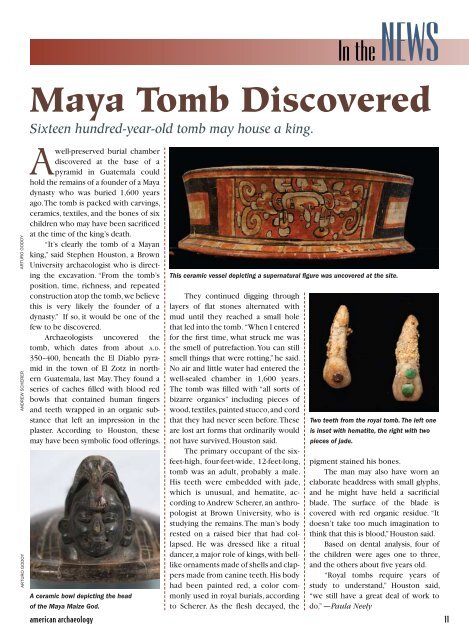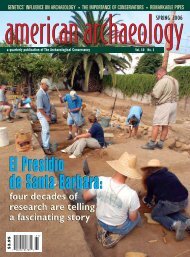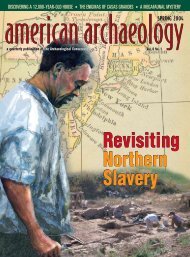Clovis Comet Debate - The Archaeological Conservancy
Clovis Comet Debate - The Archaeological Conservancy
Clovis Comet Debate - The Archaeological Conservancy
Create successful ePaper yourself
Turn your PDF publications into a flip-book with our unique Google optimized e-Paper software.
arTUro godoy A<br />
andreW ScHerer<br />
arTUro godoy<br />
In theNEWS<br />
Maya Tomb Discovered<br />
Sixteen hundred-year-old tomb may house a king.<br />
well-preserved burial chamber<br />
discovered at the base of a<br />
pyramid in Guatemala could<br />
hold the remains of a founder of a Maya<br />
dynasty who was buried 1,600 years<br />
ago. <strong>The</strong> tomb is packed with carvings,<br />
ceramics, textiles, and the bones of six<br />
children who may have been sacrificed<br />
at the time of the king’s death.<br />
“It’s clearly the tomb of a Mayan<br />
king,” said Stephen Houston, a Brown<br />
University archaeologist who is directing<br />
the excavation. “From the tomb’s<br />
position, time, richness, and repeated<br />
construction atop the tomb, we believe<br />
this is very likely the founder of a<br />
dynasty.” If so, it would be one of the<br />
few to be discovered.<br />
Archaeologists uncovered the<br />
tomb, which dates from about a.d.<br />
350–400, beneath the El Diablo pyramid<br />
in the town of El Zotz in northern<br />
Guatemala, last May. <strong>The</strong>y found a<br />
series of caches filled with blood red<br />
bowls that contained human fingers<br />
and teeth wrapped in an organic substance<br />
that left an impression in the<br />
plaster. According to Houston, these<br />
may have been symbolic food offerings.<br />
A ceramic bowl depicting the head<br />
of the Maya Maize God.<br />
This ceramic vessel depicting a supernatural figure was uncovered at the site.<br />
<strong>The</strong>y continued digging through<br />
layers of flat stones alternated with<br />
mud until they reached a small hole<br />
that led into the tomb. “When I entered<br />
for the first time, what struck me was<br />
the smell of putrefaction. You can still<br />
smell things that were rotting,” he said.<br />
No air and little water had entered the<br />
well-sealed chamber in 1,600 years.<br />
<strong>The</strong> tomb was filled with “all sorts of<br />
bizarre organics” including pieces of<br />
wood, textiles, painted stucco, and cord<br />
that they had never seen before. <strong>The</strong>se<br />
are lost art forms that ordinarily would<br />
not have survived, Houston said.<br />
<strong>The</strong> primary occupant of the sixfeet-high,<br />
four-feet-wide, 12-feet-long,<br />
tomb was an adult, probably a male.<br />
His teeth were embedded with jade,<br />
which is unusual, and hematite, according<br />
to Andrew Scherer, an anthropologist<br />
at Brown University, who is<br />
studying the remains. <strong>The</strong> man’s body<br />
rested on a raised bier that had collapsed.<br />
He was dressed like a ritual<br />
dancer, a major role of kings, with belllike<br />
ornaments made of shells and clappers<br />
made from canine teeth. His body<br />
had been painted red, a color commonly<br />
used in royal burials, according<br />
to Scherer. As the flesh decayed, the<br />
Two teeth from the royal tomb. <strong>The</strong> left one<br />
is inset with hematite, the right with two<br />
pieces of jade.<br />
pigment stained his bones.<br />
<strong>The</strong> man may also have worn an<br />
elaborate headdress with small glyphs,<br />
and he might have held a sacrificial<br />
blade. <strong>The</strong> surface of the blade is<br />
covered with red organic residue. “It<br />
doesn’t take too much imagination to<br />
think that this is blood,” Houston said.<br />
Based on dental analysis, four of<br />
the children were ages one to three,<br />
and the others about five years old.<br />
“Royal tombs require years of<br />
study to understand,” Houston said,<br />
“we still have a great deal of work to<br />
do.” —Paula Neely<br />
american archaeology 11




